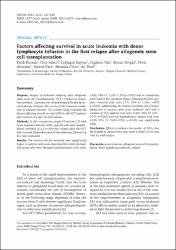Factors affecting survival in acute leukemia with donor lymphocyte infusion in the first relapse after allogeneic stem cell transplantation

View/
Date
2016Author
Kurnaz, FatihŞahin, Cem
Kaynar, Leylagül
Pala, Çiğdem
Şıvgın, Serdar
Altuntaş, Fevzi
Ünal, Ali
Metadata
Show full item recordAbstract
Purpose: Relapse of leukemia relapsing after allogeneic (allo) stem cell transplantation (SCT) remains an important problem. Cytoreductive chemotherapy followed by donor leukocyte infusion (DLI) is one of the treatment modalities in relapsed patients. The current study evaluated the factors affecting overall survival (OS) in allo-SCT patients who received DLI after the first relapse. Methods: In this retrospective study 54 patients (26 with acute myeloid leukemia [AML] and 28 with acute lymphoblastic leukemia [ALL]) in their first relapse after allo-SCT who received fludarabine-based chemotherapy followed by DLI were evaluated. Results: The relative risk for mortality was significantly higher in patients with acute leukemia (AL) within the high risk group who went through transplantation (risk ratio: 4.866; 95% CI: 2.029-11.670; p<0.001) and in transplants performed in the remission phases following the first complete remission (risk ratio: 2.371; 95% CI: 1.154 - 4.872; p=0.019). Additionally, the relative mortality risk of transplantation in patients with acute leukemia (AL) with a number of DLIs applied (risk ratio: 0.456; 95% CI: 0.29 - 0.717; p=0.001) and non-myeloablative regimen (risk ratio: 0.229; 95% CI: 0.053-0.992; p=0.049) was significantly lower. Conclusion: Efforts to enhance the number of DLIs, thus the number of infused cells, may result in better OS in cases with AL with relapse.

















